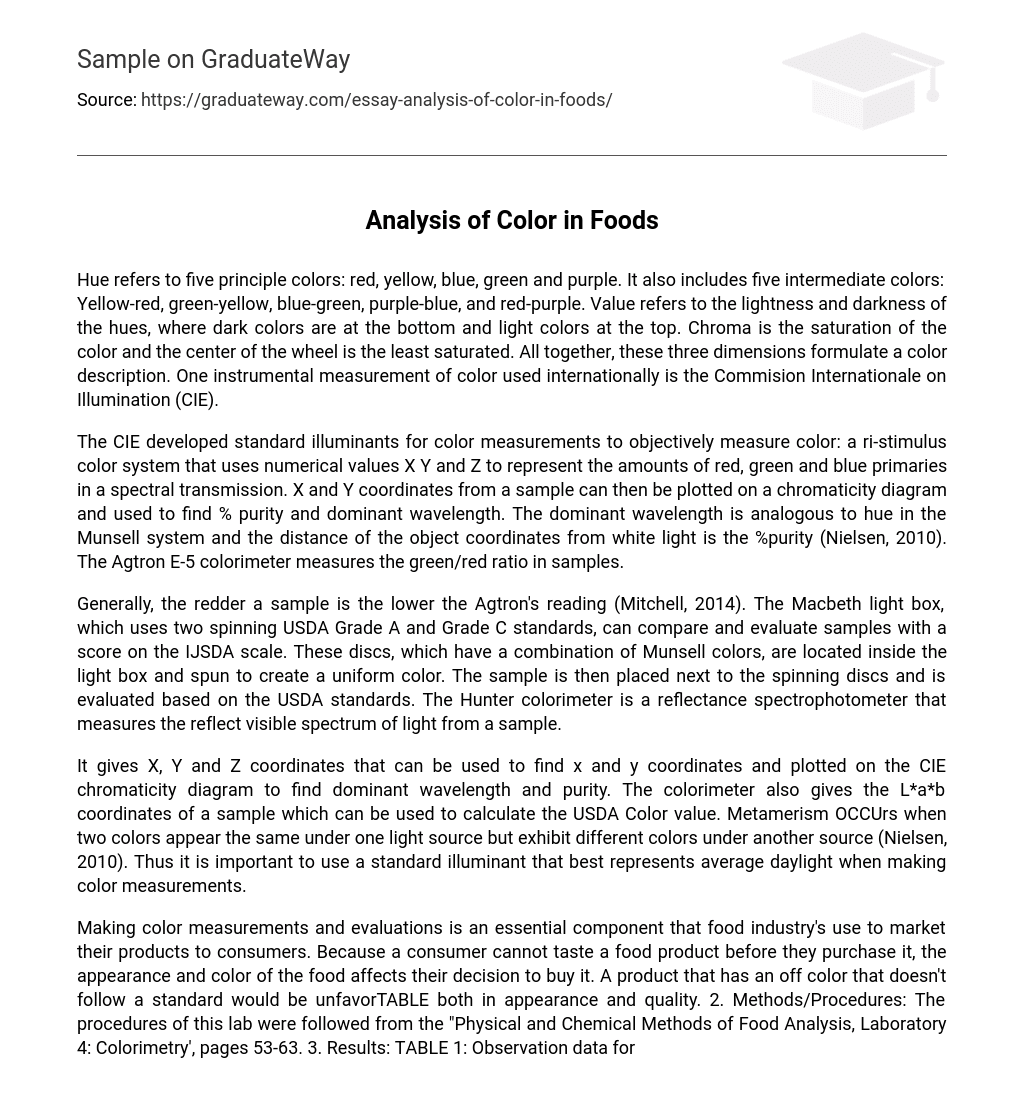Hue refers to five principle colors: red, yellow, blue, green and purple. It also includes five intermediate colors: Yellow-red, green-yellow, blue-green, purple-blue, and red-purple. Value refers to the lightness and darkness of the hues, where dark colors are at the bottom and light colors at the top. Chroma is the saturation of the color and the center of the wheel is the least saturated. All together, these three dimensions formulate a color description. One instrumental measurement of color used internationally is the Commision Internationale on Illumination (CIE).
The CIE developed standard illuminants for color measurements to objectively measure color: a ri-stimulus color system that uses numerical values X Y and Z to represent the amounts of red, green and blue primaries in a spectral transmission. X and Y coordinates from a sample can then be plotted on a chromaticity diagram and used to find % purity and dominant wavelength. The dominant wavelength is analogous to hue in the Munsell system and the distance of the object coordinates from white light is the %purity (Nielsen, 2010). The Agtron E-5 colorimeter measures the green/red ratio in samples.
Generally, the redder a sample is the lower the Agtron’s reading (Mitchell, 2014). The Macbeth light box, which uses two spinning USDA Grade A and Grade C standards, can compare and evaluate samples with a score on the IJSDA scale. These discs, which have a combination of Munsell colors, are located inside the light box and spun to create a uniform color. The sample is then placed next to the spinning discs and is evaluated based on the USDA standards. The Hunter colorimeter is a reflectance spectrophotometer that measures the reflect visible spectrum of light from a sample.
It gives X, Y and Z coordinates that can be used to find x and y coordinates and plotted on the CIE chromaticity diagram to find dominant wavelength and purity. The colorimeter also gives the L*a*b coordinates of a sample which can be used to calculate the USDA Color value. Metamerism OCCUrs when two colors appear the same under one light source but exhibit different colors under another source (Nielsen, 2010). Thus it is important to use a standard illuminant that best represents average daylight when making color measurements.
Making color measurements and evaluations is an essential component that food industry’s use to market their products to consumers. Because a consumer cannot taste a food product before they purchase it, the appearance and color of the food affects their decision to buy it. A product that has an off color that doesn’t follow a standard would be unfavorTABLE both in appearance and quality. 2. Methods/Procedures: The procedures of this lab were followed from the “Physical and Chemical Methods of Food Analysis, Laboratory 4: Colorimetry’, pages 53-63. 3. Results: TABLE 1: Observation data for cling peaches.
Safeway Kitchens Sliced peaches S&W Premium Peach Slices, Natural Style (B) -Closer to Standard -Brighter/more vibrant yellow color has a firmer texture -darker than the Standard color – peaches looked mushy and old TABLE 2: Observation data for canned tomato sauce O organics (A) Hunts (B) -Darker than Standard – Red color is very dark and the sauce doesn’t look fresh or appealing – Closer to Standard – Red color is very vibrant – looks like fresh tomatoes TABLE 3: Ranking of tomato samples against USDA Scale. Tomato sample score 49 42 c TABLE 4: Data from the Agtron E-5 colorimeter for tomato samples.





